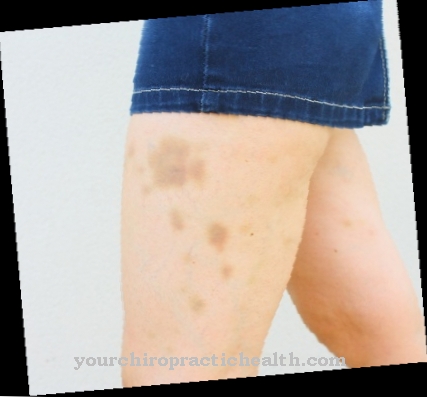pus or Pus (hence the term pustules) is caused by the melting of tissue by leukocytes in an area of inflammation. The pus can therefore be understood as a biological degradation product of the body. Mainly pus is found in inflammation of the skin, the gums and inflammation of the hair roots.
What is pus

Pus is a mostly yellowish secretion that occurs as a result of an inflammatory reaction within the cells of vertebrates, including humans. The basis of the underlying inflammation, which causes pus due to the body's own defense against leukocytes, bacteria and tissue breakdown, is usually a bacterial infection.
Basically, pus is the body's defense reaction to infection and shows that it is fighting against it. Pus can have very different consistencies (thick or thin), and the color can vary from yellow to blue-green. The smell also differs depending on the type of bacteria. If the pus dries up, it means that the healing process is in progress.
In rare cases, pus is non-infectious. This can be the case, for example, with pustular psoriasis (psoriasis).
causes
Pus is basically a defense function of the body in response to invading bacteria. The mostly yellowish liquid is created by the use of leukocytes in the body, helper cells that, when dying, dissolve together with tissue and bacteria in pus. Often pus develops for no apparent reason, that is, without an infection being apparent.
Basically, pus can build up all over the body. An encapsulated collection of pus in the tissue is called an abscess. In body cavities one speaks of empyema. A boil - an inflamed hair - is called a boil.
Pus blisters are called pustules (from the Latin pus = pus). In addition, suppuration can also occur in the teeth or eyes. The age-related pus-filled pimples in puberty are also known, but they are part of normal hormonal changes.
Diseases with this symptom
- Chagas disease
- Stye
- Pericarditis
- Inflammation of the nail bed
- Hand, foot and mouth disease
- Tonsillitis
- Impetigo contagiosa
- Bartholinitis
- Nasal furuncle
- Ear furuncle
- Ulcus molle
- Mastoiditis
Complications
If abscesses develop from the pus, there is a risk that the inflammation will spread further. Phlegmon, an enlargement of the focus of pus in the connective tissue, often accompanied by severe pain and redness in the affected area, as well as fever and warming of the skin can occur. If such an abscess occurs in connection with other diseases or with an already weakened immune system, in extreme cases it can lead to organ failure or circulatory collapse.
Diseases with a risk factor: alcoholism, various cancers and diabetes mellitus. Pus can also lead to complications, such as when it gets from a wound into the bloodstream or organs. The main dangers here are the development of various types of poisoning or even edema when an abscess in the brain or the jaw region opens and the secretion gets into the brain.
Such a brain abscess leads to headaches, nausea and vomiting on the one hand and serious speech and vision disorders up to paralysis and epileptic seizures on the other hand, thanks to modern medicine, however, is rarely fatal. The surgical intervention, which is necessary to remove the abscess, is also not without risk and in the worst case can lead to permanent brain damage.
Corresponding abscesses can also occur in the organs, whereby the complications depend on a wide variety of factors and can vary greatly from person to person.
When should you go to the doctor?
Pus is easily recognized by its yellow color. The secretion forms when there is inflammation. Purulent inflammation is almost always based on a bacterial infection involving white blood cells, the leukocytes. They work as the body's own defense. So pus means struggle in the body. There are few exceptions where pus is not caused by infection. An example of this is psoriasis.
Pus can form anywhere in and on the body. Nobody should put off a visit to the doctor here. The cause must be found as soon as possible so that treatment can be initiated quickly. Since pus means a stressed and weakened immune system, the entire body is accordingly vulnerable. In the worst case, it can even lead to circulatory collapse or organ failure. Pus in the abdomen can also be dangerous. A classic example is the "ruptured appendix".
If the inflamed appendix is not operated on in time, it will tear open due to the pressure of the pus that collects in it, whereupon the secretion spills into the abdomen with potentially life-threatening consequences. A similar event can occur with further accumulations of pus in the body.
By now it should be clear how important a visit to the doctor is in the case of pus secretions or accumulations of pus. Fear of a possible operation, which may be necessary here, should not deter anyone from seeing a doctor.
Doctors & therapists in your area
Treatment & Therapy
Basically, pus is first treated by breaking it open, that is, bringing it to a drain. Septic surgery works by cutting open abscesses and laying drains. Irrigation-suction drains are also common to keep a wound clean. Antibiotics, on the other hand, are only effective in certain cases (such as liver abscesses), but not at all in others, as they do not even penetrate to the concentrated core of the pus.
Bringing the pus to the drain is necessary to avoid possible blood poisoning. It is also intended to prevent spreading in the body. This knowledge comes from ancient times.
Honey has long been known as a home remedy. In the case of purulent inflammation on the skin, it is simply applied, closes the wound and damages the bacteria. However, the honey must not have been heated. Chamomile tea or St. John's wort oil also have anti-inflammatory effects. Of course, if serious infections or internal abscesses develop, a doctor must be consulted to clarify the causes and initiate treatment.
Outlook & forecast
If a collection of pus forms on a wound, this should always be assessed by a doctor. If a pus bubble develops, it should never be opened yourself. This should also only be done by a specialist. Opening a pus bladder can have serious consequences, such as blood poisoning.
Often pus forms when the hair roots or gums become inflamed. As a rule, such inflammations should subside after around three to four days. If after this time there is no improvement or if the formation of pus has increased, a doctor should be consulted urgently. If such wounds are not treated by a doctor, an abscess can form, so that the inflammation spreads further in the body. A visit to the doctor should not be postponed for a long time in the event of an accumulation of pus, because the cause must be clarified and treated as soon as possible.
Taking antibiotics can effectively reduce the build-up of pus. Other active ingredients, such as chamomile, also have an anti-inflammatory effect and prevent the further formation of pus fluid.
prevention
Pus in a wound that has already been cleaned can only be kept away by keeping the wound clean and preventing new germs from entering. When treated with antibiotics, they must be taken after the symptoms have subsided to kill weaker bacteria that could otherwise multiply again.
Otherwise means preventing pus formation: preventing a bacterial infection. Depending on which bacteria are the cause, various preventive measures come into question.
Pus pimples and pus in the context of pronounced acne should first be examined by a dermatologist and treated and prevented with suitable means. For more information on this topic, see our articles: Acne and Pimples.
You can do that yourself
Pus occurs in all people and does not necessarily have to be a medical complication. It occurs mainly on wounds or pimples. Where there is pus, it should definitely be broken. By breaking open the pus, infection of the blood can be prevented and the pus can drain away. This relieves the wound and thus promotes healing. However, minor wounds and pimples will heal even if the pus is not left out. The process here usually takes a little longer.
To remove the pus, it must be broken open with a sharp object. A needle or tweezers can be used for this purpose.However, the patient should be careful not to injure surrounding areas. After the pus is broken, it drains. Here the affected person can still help by pressing and thus enable the complete discharge. The area should always be disinfected after pressing. Rinses and other cosmetic products are suitable for this.
If there is a large accumulation of pus, it should be removed by the doctor. Inflammation and infections can occur as a result of improper removal. Usually the wound heals after a few days and does not lead to any further complications.



























